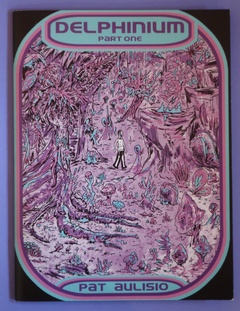With this month’s Comix Club drawing nigh (that’s Tuesday, August 29 from 5:30–7:30 p.m. in the Art Department), here is a Review Spotlight of sparkly new additions to the Philadelphia Comics Collection. Each review contains a recommendation of similar or related comics, which are also available in the Philadelphia Comics Collection.
The first time I leafed through the pages of 100 Life Hacks by Ben Miller, a wave of nostalgia washed over me. This loose assemblage of observations and tips reminded me of the days I’d spend in my state college’s computer lab, scrolling through comics on Tumblr, and reading humorous quips captured in one-or two-paneled comics with cartoonish characters strolling lankily towards a minty toothpaste-colored sunset.
For me, Tumblr was the homebody of the internet: a stripped-down corner of the blog-o-sphere that was totally content with a knack for getting weird and chuckling (reblogging) unto to itself, in perpetuity.
Miller certainly knows how to get weird, and you can see him do just that in 100 Life Hacks. Some of my favorite bits in these pages are the curvy elbows and stubby feet of his numerous characters, many of whom evoke moods of a surprising depth while struggling to hold a wine glass (see the mustachio’d character on one page seated at a red tablecloth, opposite an empty chair, for reference).
Perhaps predictably, the centerfold stretch-limo page is my favorite. A mad-packed list of hacks rains down from both pages, as a long red Corvette joins this deluge of genius ideas together. Occupying the stretch Corvette are many babes, a ghostly lady, a wig-donning shocked frog, two Hilary Clintons (?), and a man in a button-down enjoying the boombox in his arm. Above this party, hacks such as these read: “Summer Backyard BBQ Idea: Fill up a hammock with potato salad”, and “Horoscopes are good for seeing the future, but horseoscopes are these things I made that are good for looking at horses.” All of this is to say, buckle up for one heck of a ride!
See also: The Lil Tronny anthology. Stories and Art Vol. 1 by Lewistron, and Lil and Friends Die for Real: A Comic/Look-and-Find Book by Catherine Epps.
As Jaz Malone unassumingly puts it, her 2019 zine, Smile is “a collection of self-portraits that I didn’t feel like throwing out for some time. In this format, they can take up space on my shelf, instead of my floor.” This utilitarian twist hints at the funny notes and musings you’ll find within Smile’s brief, yet compact, pages. Malone has compiled more than 30 self-portraits that read like an intimate visual diary. Her drawings, sometimes colorful, are cropped and assembled in a way that feels like an accordion scrunching close when aiming to make a particular point, only to playfully unravel with the turn of a page. We become familiar with the artist’s features, as they orbit around each drawn visage in a blind study, or glow, with layered pastel, like a familiar corner store lit up at night.
It’s common for artists to grow weary and perhaps misgiving about a subject they’ve committed to waxing about for some extended period of time. I appreciate those facial expressions Malone captures in herself that I think must play about on my own face when I’m several coffees in and trying to put together yet another drawing in my sketchbook that feels the same, but different. But when the artist’s subject of choice is their own physical form, this practice of revisiting takes on a confronting vulnerability. We then witness, along with the artist, a progression of turning time and again, back to an object that might be a mask to others during the day, as well as the key to exploring a deeper understanding of oneself.
One signature element to these portraits that I enjoyed following in Smile is the shift and stretch applied to the artist's glasses. On one page, we see Malone has drawn herself with a measured gaze clocked slightly to the side; her frames are rectangular and amber-hued in one of the more color-filled renderings in the series. A couple on, the artist’s frames are more simply represented by two heavily-circled spheres in a portrait that is sketched in charcoal with lines that are gestural and thickened over with much certainty. However, Malone’s frames are missing eyes, making her expression perhaps fogged-over, distant, and blank. In yet another charcoaled portrait, the artist’s frames are absent, and the figure instead squints vulnerably at the viewer, effusing humor in the absence of the familiar.
In contrast with this ever-shifting gaze, what Malone seldom changes is the mouth to her expression, and she makes note of this, perhaps self-consciously. In a portrait begun in charcoal, the artist evokes a desire to “correct” or try on a persona by drawing in her expressions with pinkish-red lines. Of a slightly upturned mouth, and eyes that lift towards the upper edges of her glasses, Malone writes simply, “One smile. Looks weird.”
See also: affect/effect by Grace Snyder, and The Many Moods of Anna by Anna McGlynn.
If you’d like to scratch that obsessive drawing exercise itch, you can make an in-person visit to the Art Department reference desk, and request to see an abbreviated version of Matt Madden’s 99 Ways to Tell A Story from our Artist Files. This short zine explores numerous ways to illustrate the same series of events through changes in style, points of view, and development. The full version of 99 Ways to Tell A Story is also available on the Philadelphia Comics Collection shelves.
Delphinium: Part One, a 28-page comic by Pat Aulisio, opens full-spread with its hero standing over the eye of a hurtling storm. Briar Phlox is part of a four-astronaut team that is studying a new planet they call “Delphinium” (named after a tall drink of stalky toxic purple plant, hmm, what could be going on there?).
Our journeyman appears to have drawn the teeny straw among his colleagues, as he’s tasked with venturing outside of the space station he’s known as home for 26 months to check on the hub’s communications satellite. From the very start, things do not look good for Phlox; the brewing storm blankets the strange and foreboding planet, both blotting out nearly two total pages, as Phlox stands small on a dinky platform. This image harkens to mind the same sense of terror I felt in watching Sandra Bullock lose control in outer space, in Alfonso Cuarón’s 2013 galaxy thriller, Gravity.
Soon enough and just like Sandra, a freak accident catapults Phlox away from his team and toward the amethyst-colored unknown. When the astronaut’s parachute first breaks ground, Aulisio depicts a jungle-like biome that’s lush with drawn fauna. Phlox notes that some of the mushrooms and plants look familiar to Earth’s terrain. The oxygen levels on Delphinium are similarly sustainable for life.
Phlox removes his helmet, revealing a face that is haggard and weary. Here, the inked backgrounds make a startling shift from detailed representations of plant life to grainy, blown-up photographs of thick forests teeming with exotic plants. This contrast in realistic life and Phlox’s inky, cartoonish presence is one of my favorite parts of the comic, as it conveys the sense of unreality in such a cool and almost cinematic way. It is against this backdrop that we first get a zoomed-in view of Phlox’s withdrawn mug. One can guess that perhaps the shadows Aulisio uses to hollow out the astronaut’s features are the result not just of recent events, but of the months-long mission that is now Oz-like in its unraveling. Phlox’s face makes me think of those before-and-after photos of Obama at the beginning and the end of his presidency (to be clear, Phlox looks decidedly like end-of-term Obama). Does Phlox’s landing make him the President of Delphinium? If that’s the case, he’s like the coolest President ever. I won’t spoil the rest of Part One, except to say that there is one man on a planet full of shrooms. And you lucky duck, can take a look at the trippy terrain contained within these pages by paying a visit to the Philadelphia Comics Collection.
For other works by the artist, see Zone Keeper. For further musings on traveling to the unknown, see Simulation by Nicole Rodrigues.
Have a question for Free Library staff? Please submit it to our Ask a Librarian page and receive a response within two business days.



